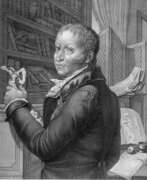Anatomists 18th century


Paolo Mascagni was an Italian physician and anatomist.
He graduated from the University of Siena in philosophy and medicine, becoming a professor of anatomy there and focusing on the human lymphatic system. Mascagni outlined his discoveries in a book with detailed illustrations of each part of the lymphatic system he identified. In studying the lymphatic system, Mascagni refined the technique: he injected mercury as a contrast agent into the peripheral lymphatic networks of a human cadaver and, by tracing the movement of mercury into other parts of the system, was able to create detailed diagrams and models. By studying physiology and pathology, he was able to emphasize the importance of the lymphatic system in combating diseases of the human body, which helped to develop new treatments.
Mascagni helped to enrich the collection of wax anatomical figures in the Florence Museum, and commissioned the sculptor Clemente Susini to make a full-scale model of the lymphatic system in wax, which can still be seen in the Museum of Human Anatomy at the University of Bologna. Mascagni created the Anatomia universale ("General Anatomy"), a huge unbound book of 44 copper sheets with anatomical illustrations. The scientist pursued the task of collecting in one book the entire body of knowledge about the anatomy of the human body. Each plate is made in such a way that drawings relating to one plane of dissection can be placed together and show the whole body in life-size.
In addition to anatomy and medicine, Mascagni was interested in mineralogy, botany, chemistry, and agriculture.


Johann Friedrich Meckel the Younger was a German anatomist, biologist and professor of anatomy.
Meckel came from a family of physicians; his grandfather and father were physicians and anatomists and had their own anatomical museum at home. Meckel studied medicine at the universities of Halle and Göttingen, writing his doctoral dissertation on congenital anomalies of the heart. As a pathologist, he specialized in the study of congenital malformations and aspects of lung and blood vessel development. He also described Meckel's diverticulum, which he discovered during a pathologic examination, and became the founder of the science of teratology.
After Napoleon's occupation, the University of Halle reopened in May 1808, and Meckel was appointed professor of surgery, normal and pathological anatomy, and obstetrics. He taught throughout his life, continued to conduct research in pathology, and collected specimens for his collection. The scientist was the author of numerous articles and several multi-volume treatises, including one on pathologic anatomy and an atlas depicting human anomalies. His principal labors were devoted to the comparative morphology of vertebrates. In 1810 he completed the translation of Cuvier's (1769-1832) five-volume Leçons d'anatomie Comparée from French into German.
Meckel was a member of the German Academy of Naturalists "Leopoldina," a corresponding member of the Paris Academy of Sciences, and a foreign member of the Royal Society of London.


Christoph Jacob Trew was a German botanist.
He was originally a city solicitor, court physician, Count Palatine of the Holy Roman Empire, an advisor to the Margrave of Brandenburg-Ansbach. He also had an academic passion for botany. He was a member of the Royal Society of London, the Berlin Academy, and the Florentine Botanical Society. His interest in botany then led him to sponsor the publication of illustrated botanical books.


Samuel Thomas von Soemmering was a German physician, anatomist, anthropologist, paleontologist, physiologist and inventor.
He studied medicine at Göttingen, where he received his doctorate, and in the same year became professor of anatomy at Kassel, then at Mainz. Among Soemmering's contributions to biology are the discovery of the macula in the retina of the human eye, studies of the brain, lungs, nervous system, and embryonic malformations, and he published many papers in the fields of neuroanatomy, anthropology, and paleontology. He was the first to give a reasonably accurate account of the structure of the female skeleton.
Soemmering also worked on fossil crocodiles and pterodactyls, which at the time were called ornithocephalians. In addition, Soemmering dabbled in chemistry, astronomy, philosophy, and various other fields of science. Among other things, he investigated the refinement of wines and sunspots, and designed a telescope for astronomical observations. In 1809, Soemmering developed a sophisticated telegraph system based on electrochemical current, which is now preserved in the German Science Museum in Munich.

